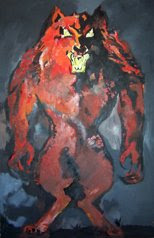I’m spending time with a cop. Her name is Zulaika. She’s a motorcycle cop on the Panama City Municipal Police Force. It is almost humorous, as Zulaika is tiny and rides a 200cc motorcycle; it would be humorous, except that she can muster such a serious set to her jawline.
Zulaika speaks only Spanish. She’s 25 years old and she’s never left Panama, hardly ever left Panama City. I call her "fascistita" because all cops are fascists, and she calls me "casperito" after Casper the Ghost. She wants a baby in a couple years, and she told me that I should come back then so she can have a green-eyed baby. Unfortunately, as I’ve tried to explain to her, green eyes are recessive.
She asked me once, "Will you fight?" which is a line typically used by men on women in Panama, the implication being: "Will you fight when I rape you?" If you are interested, the appropriate response is: "Yes, I will fight."
Staying in the Casco Viejo, or "Old Town," of Panama City. This is the site where the Spaniards moved the city after the buccaneer Sir Henry Morgan sacked and burned the original in 1671. The event is fancifully described by the American writer John Steinbeck in his novel, Cup of Gold. The "Cup of Gold" referred to in the title is Panama City.
The hotel has a garden patio on the roof. To the right, the Bridge of the Americas and all of the ships standing offshore in the Pacific waiting to transit the canal. To the left, across the inlet, the clustered line of skyscrapers that make up downtown Panama City. At night, the lights are everywhere, and the proprietary Panamanian Spanish-language reggae music thrums up from the bars. And last night, fireworks and firearms were going off all over the city. The hotel has no hot water, but one doesn’t notice, because the weather is so hot.
The Casco Viejo includes the Plaza Francia. The French embassy stands there, and a promenade encircles a monument to the French attempt to build a canal in the 1880's. 22,000 people died in the effort, most of them from France and the French Caribbean islands of Martinique and Guadalupe. One director of the project arrived in Panama from Paris with his wife and two sons, and returned to Paris two years later with three caskets. The French finally gave up in 1889.
The street food is tragic. Fried chicken and chow mein. I’m so far from Mexico now. I’d give my boots for a corn tortilla and some salsa, or half a pickled jalapeno.
This December was the 15th anniversary of the American invasion of Panama. The news media carried coverage of the events held in the cemeteries to commemorate the people killed by the American military during Operation "Causa Justa." The Americans' "Just Cause" was to remove their own ex-collaborator, Noriega, who had gotten out of their control.
Zulaika was 10 years old then and remembers American soldiers camping in front of her house.
Saturday, January 1, 2005
Subscribe to:
Posts (Atom)




